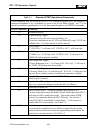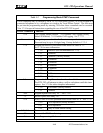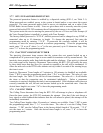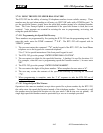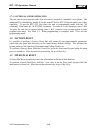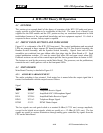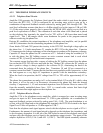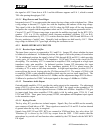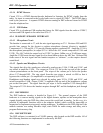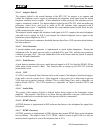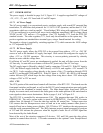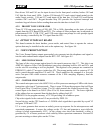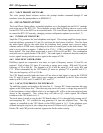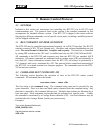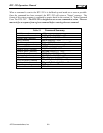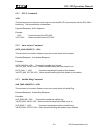
RTU-292 Operations Manual
4.3.3.4 DTMF Detector
Circuit U25 is a DTMF detector/decoder dedicated to listening for DTMF signals from the
radio. Its input is connected to the leveled radio receive signal at U20B-7. The DTMF data is
read by the processor. A separate DTMF detector running in DSP software listens for DTMF
from the telephone line.
4.3.3.5 FSK Modem
Circuit U26 is a hardware FSK modem that listens for FSK signals from the radio at U20B-7,
and can send FSK signals to the radio from U26-17.
4.3.4 HANDSET/ SPEAKER INTERFACE
4.3.4.1 Microphone Circuit
The handset is connected to J7, with the mic signal appearing on J7-5. Resistors R50 and R51
provide bias current for the electret or carbon microphone element (electret is standard).
Components L3, C20 and L4, C23 provide filtering against conducted RF. Amplifier U13A is
the microphone preamplifier; its output U13A-1 drives the ALC circuit composed of U14A and
U13B. The ALC holds the output level at U13B-7 to about -9dBm over a 30 dB input range.
Amplifier U15B boosts the mic signal level to about 0dBm to drive the MIC bus. Resistor R64
feeds some of the mic signal into the handset earpiece as “sidetone”, so the earpiece doesn’t
sound dead.
4.3.4.2 Speaker and Headphone Circuits
The signals that drive the speaker are selected by analog gates U18A, U18B, and U18C; and
are mixed in amplifier U16A. The output on U16A-1 is fed to the top end of the speaker
volume potentiometer on the front panel. The wiper of the volume pot is fed to the speaker
driver U17 through R89. The ring signal from the tone ringer is mixed via R88 so that it
bypasses the volume pot. (Its amplitude is set separately by R156).
Headphones and handset signals are selected by analog gates U19A, U19B, and U19C; and
mixed in amplifier U16B. Output U16B-7 is applied to the top end of the headphones volume
pot on the front panel. The signal from the pot wiper is fed to amplifier U15A through R65.
The output of U15A drives the handset earpiece through R67 and the headphone jack through
R68.
4.3.5 DSP MODULE
The DSP hardware circuitry is detailed in Figure 8-3. The general purpose of the DSP
hardware is to convert analog signals to the digital domain, operate on and manipulate these
signals digitally using the DSP chip, then convert the result back to analog. In this way, it is
possible to implement functions such as the adaptive hybrid, which would be impossible or
impractical to implement using purely analog techniques. In addition to the DSP chip itself, the
module contains two analog interface chips, static RAM for audio storage and delay, and a
program flash memory chip.
4.3.6 DSP SOFTWARE
The DSP software is contained in a FLASH memory chip located on the DSP module. All of
the following functions are implemented in software by the DSP
JPS Communications, Inc.
4-22



